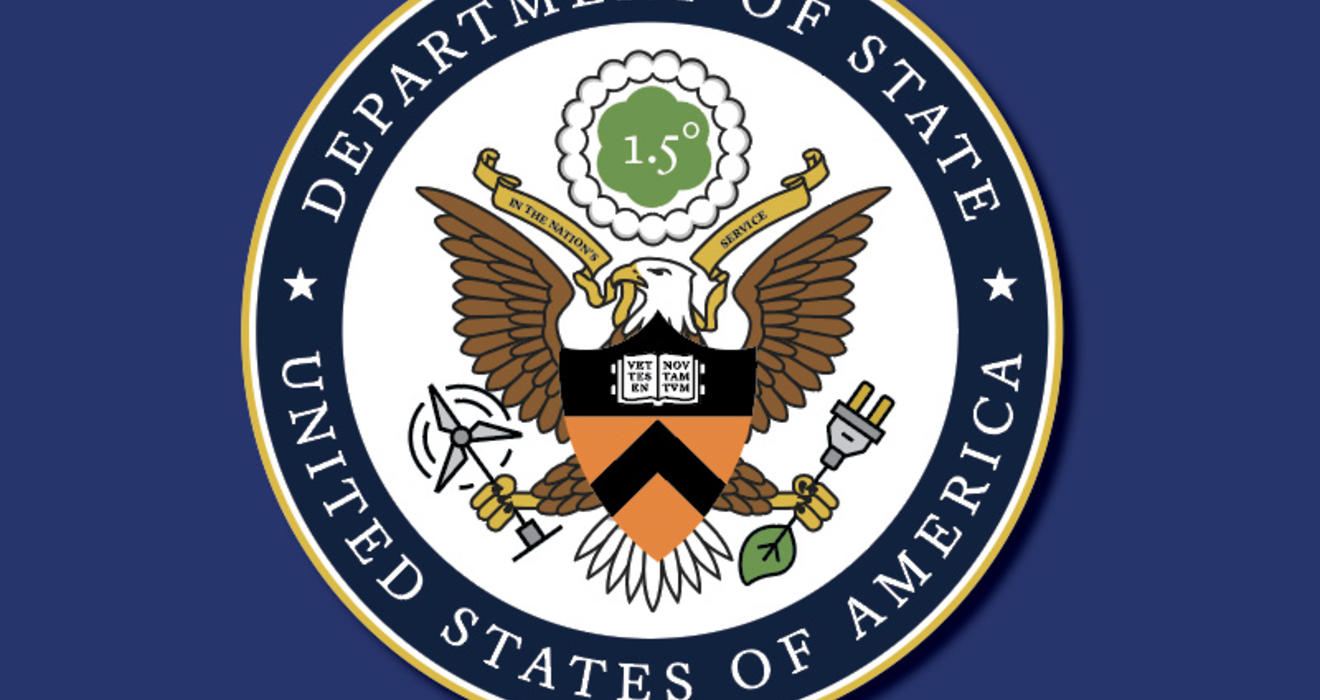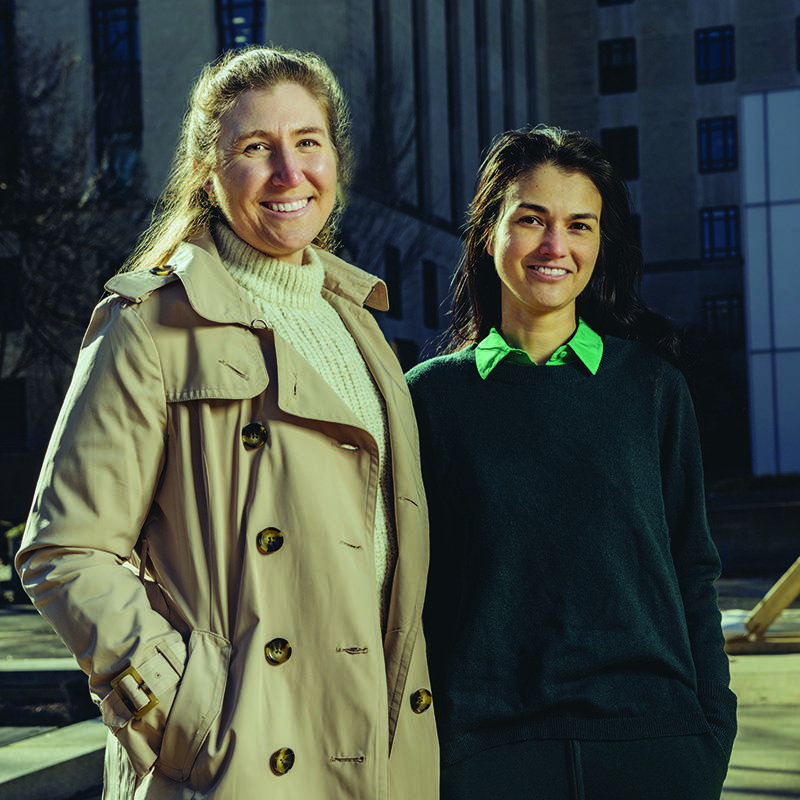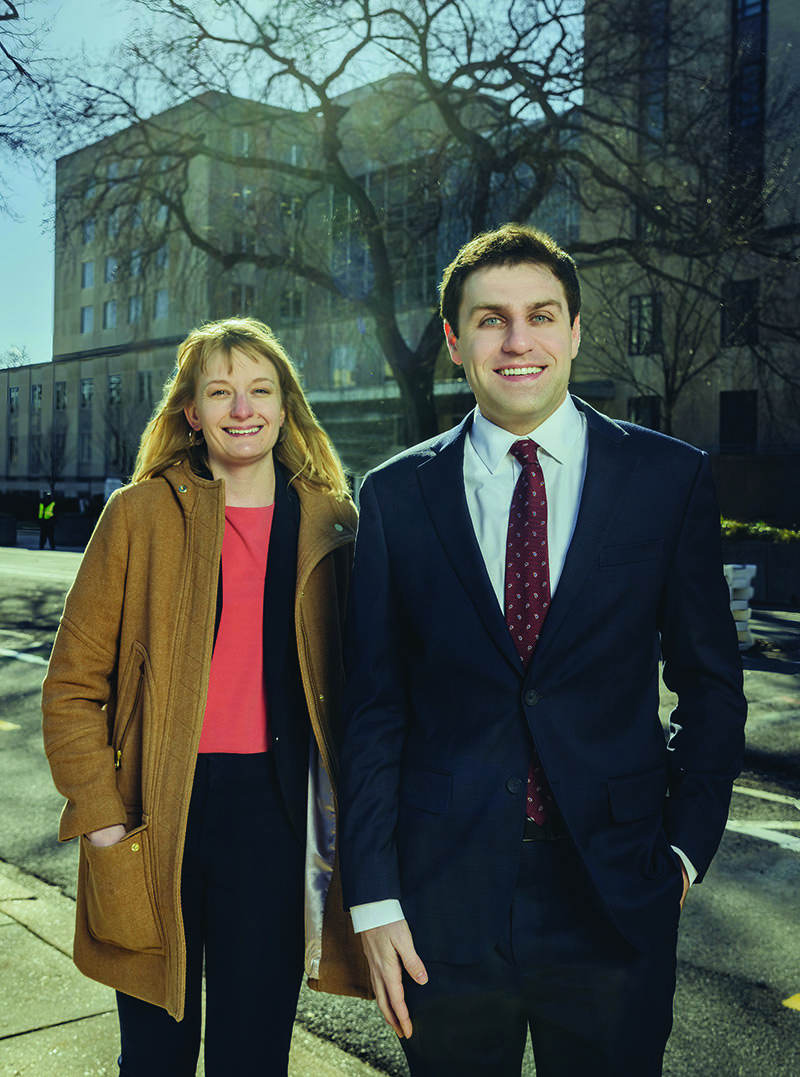
From Princeton to Policymakers
Tigers at the State Department are helping to forge international agreements around climate change
When the last session of week one ended at the 27th UN Climate Change Conference (COP27), held November in Sharm El Sheikh, Egypt, most diplomats retired to their rooms, keen to recharge after five long, draining days of negotiations. But for Sierra Woodruff ’11, a lead negotiator for the U.S. delegation, work was just beginning.
Woodruff is one of six Princeton alumni serving on the State Department’s climate team, and one of four Princetonians who represented the U.S. at COP27. Alumni may not yet think of the University as a climate policy powerhouse, but it has, in recent years, become one, producing leaders working at the highest level of government on what is arguably the most pressing global issue of our time.
Now, Woodruff was focused on an especially controversial, and historically intractable, matter in climate diplomacy: Loss and damage. The possible transfer of resources from rich to poor nations to deal with climate-driven crises. In particular, she was working with foreign delegates to design the Santiago Network, an international system proposed in 2019, at COP25, to provide resources and technical assistance to developing countries. Yet after days of official talks, negotiations remained at a standstill.
“That first week, we were working really hard but were just not making quite enough progress,” Woodruff recalls. “The major breakthrough came when we ran out of time.”
An hour after official talks closed, Woodruff and representatives from other key stakeholder nations — including the EU, the Alliance of Small Island States (AOSIS), and the Indo Latin American Chamber of Commerce (ILACC) — reconvened for a night of informal negotiations.
“We all sat in a circle, and conceptually took a step back, and said, ‘All right, what do we want out of this?’” Woodruff says. “And without putting anything down on paper, we spent almost a day talking at that high level. I think having a more informal conversation that wasn’t on the clock broke down some of the barriers. It was kind of an amazing moment.”
The next evening, Woodruff and four other delegates stayed up through the night drafting an agreement. After three more days of revisions in the second week of COP27, the agreement was ratified.
“There’s still work to be done [on the network],” says Woodruff. “But it was definitely a sign of progress.”
Of the four Princetonians who represented the State Department in Egypt, the most senior was Richard Duke *02, who serves as deputy to Special Envoy for Climate John Kerry. The youngest was Jonathan Moch ’12. While Woodruff was wrangling support for loss-and-damage measures, Duke and Moch were working together — using interdisciplinary skills both had developed while taking classes in the Department of Geosciences and the School of Public and International Affairs (SPIA) — to negotiate carbon emissions reduction agreements with several developing countries.
“Over the years, I’ve worked with many Princeton alumni from the School of Public and International Affairs,” says Duke, who completed his Ph.D. in public affairs. “And it is always useful to have colleagues who have a similar toolkit to mine, including a deep understanding of applied economics and scientific literacy. That allows us to really be effective on an issue like climate change, where you have to weave those things together every day.”
While Duke’s core academic focus at Princeton was economic policy, Moch majored in geosciences, a course of study he chose after taking a freshman year climate science course TA’d by Ian Lloyd *11, another member of the State Department’s climate team. Lloyd — who missed this COP due to paternity leave — grew up in the U.K. and completed his B.A. and masters in physics at Cambridge, but he was drawn to Princeton by its dual strengths in climate science and public policy.
“The link at Princeton to the Geophysical Fluid Dynamics Laboratory really gives them an incredible additional resource on the climate modeling side,” says Lloyd, who was admitted to several top environmental science programs, in both the U.S. and the U.K. “Plus, I could see some of the potentially infinite linkages with the School of Public and International Affairs. So I could see, even at that point, that there could be opportunities to take a more interdisciplinary approach, which was hard to find.”
Like Lloyd, Moch studied in both departments to build a policy-oriented skillset. While he was a committed geosciences major, spending his summers conducting scientific research — “It was pretty exciting for an undergrad to have the opportunity to work with a world-class climate modeling laboratory,” he recalls — he also completed a certificate at SPIA, a de facto second major that’s no longer offered. The grueling academic regimen required him to write four junior papers, one of which Lloyd helped advise.
“I was, like, grading his papers,” says Lloyd, laughing. “Now we’re in the same office.”
“My TA for the class that got me excited about climate in the first place is now one of my colleagues,” says Moch.
After completing his Ph.D. in Earth and planetary science at Harvard, Moch sought career advice from Lloyd, who by then was working for the State Department. Soon thereafter, Moch — like Lloyd — secured an AAAS (American Association for the Advancement of Science) Science and Technology Policy Fellowship to join the State Department’s climate team. At COP27, Moch assisted Duke in negotiations by providing scientific and technical insight.
“Jonathan’s deep scientific expertise helps our team develop strategy and set priorities for directing Secretary Kerry’s time and securing diplomatic leverage,” says Duke.
According to Moch, Duke didn’t need much help.
“One of my other bosses said to me that Rick, in some ways, is not good practice for you, because he’s so technically astute that you don’t have to explain much.”
The two worked together to achieve a trio of ambitious bilateral agreements with Egypt, Mexico, and Indonesia.
The Just Energy Transition Partnership (JETP) with Indonesia, for example — a plan to help Indonesia radically reduce its power sector emissions — is projected to save more than 330 megatons of CO2 emissions by 2030, and well over 2 gigatons of CO2 by 2060. By comparison, the EU emits roughly 2.7 gigatons per year.
“It’s a very tiny part of the solution,” says Moch. “But every tiny part counts.”
Since joining the federal government in 2009 under the Obama administration, Duke has applied his interdisciplinary skillset to make headway on an issue that once seemed intractable. He played a critical role in crafting and marshaling diplomatic support for some of the most consequential global climate policies to date — policies that have, within roughly five years, cut projected warming this century almost in half, virtually eliminating the possibility of the most catastrophic climate outcomes.
Duke graduated from Brown in 1992, the same year Al Gore published his first book on climate change, Earth in the Balance. Deeply influenced by Gore’s book, Duke came to Princeton in 1997 to do an MPA at SPIA, and he stuck around to complete a Ph.D. in public affairs, writing a dissertation that explored how to commercialize renewable energy technologies.
“The Princeton graduate school experience for me was a combination of practical and conceptually deep economics training with scientific literacy,” says Duke. “That experience really did deliver for me a sure footing intellectually on what it takes to set policies in place that are durable, and that achieve the level of global transformation that we need to achieve net-zero greenhouse gas emissions.”
In the two decades since Duke left Princeton, he has lived through a marked change in international climate diplomacy. Early in his career, diplomats focused almost exclusively on international treaties to curb CO2 emissions. But in recent years, Duke has played a pivotal role in pushing the U.S. to pursue more informal partnerships, often targeting less-talked-about, but more potent, greenhouse gases. The success of these efforts has established a new model of climate diplomacy.
“The formal, textual negotiations remain crucial, including as a signal of intent and of commitment,” says Duke. “But what has emerged more and more, and what was very clearly in the foreground at COP27, is this complementary action agenda, where on a bilateral basis, on a plurilateral basis, in some cases on a near-consensus basis, we see countries more agilely working together to actually get the job done on climate.”
Duke was the behind-the-scenes architect of one of the most significant informal agreements yet: the Global Methane Pledge, which seeks to curb emissions of a heat-trapping gas roughly 80 times more potent than CO2 over a 20-year timescale.
“One of the things that really pops out [when reading an Intergovernmental Panel on Climate Change, or IPCC, report] is that fully half a degree centigrade of today’s net 1.2 C degrees of climate change is caused by methane that’s already in the atmosphere,” says Duke, whom a colleague called “the methane man.”
“And in looking at those plain facts two years ago, there was a certain mismatch between that reality and the scant attention on methane in the climate conversation, globally.”
After drawing Kerry’s attention to this “mismatch,” Duke and Kerry mobilized support within the U.S. government for a methane pledge, and then began pursuing informal agreements with other nations. At COP26 in Glasgow, the U.S. launched the Global Methane Pledge, with 100 signatories agreeing to cut methane emissions by 30% by 2030. At COP27, another 50 countries signed.
“Now, of course, the work is to convert that into real reductions in methane,” says Duke. “But that was not a formal negotiated outcome — that was a nimble political declaration. So it’s really on that action agenda, in its many different forms, that you see the evolution of these COPs from a pure focus on negotiation in the early days, to a more balanced combination of negotiations and action.”
Duke has also played a pivotal role in more conventional international treaties, mobilizing support for the most significant multilateral agreement you have probably never heard of: the Kigali Amendment to the Montreal Protocol.
The Montreal Protocol was an international treaty established in 1987 to protect the ozone layer by curbing the production of chlorofluorocarbons (CFCs), which were used in air conditioners and refrigerators. But after the treaty, manufacturers replaced CFCs with hydrofluorocarbons (HFCs) — compounds that pose no threat to the ozone layer, but which are extraordinarily potent greenhouse gases. The Kigali Amendment proposed to gradually reduce the production of HFCs, but it gained little traction when introduced in 2016. During President Barack Obama’s second term, Kerry (then secretary of state) tasked Duke (then special assistant to the president) with marshaling domestic and international support for the amendment — and last fall, after years of effort, the U.S. Congress ratified the amendment on a broadly bipartisan basis.
“That is a critical global success story,” says Duke. “The benefit of that single agreement is as much as half a degree centigrade of avoided climate change by 2100. That’s part of why we’re not talking about four degrees centigrade anymore.”
While Woodruff was working on loss and damage, and Duke and Moch were negotiating informal emissions reduction agreements, Emily Seen ’08 — whom Woodruff referred to as “the subnational powerhouse in the office” — was working at COP27 to help local governments coordinate decarbonization strategies.
Seen studied human rights at SPIA as an undergraduate, and then spent several years working as a legislative aid and an intern in the Office of First Lady Michelle Obama ’85 before finding her calling in climate policy.
“I think that kind of Woody Woo, idealist, ‘Princeton in the nation’s service’ idea — it’s part of my ethos,” says Seen. “It’s what I really believe in. It’s cool to work on an issue that matters so much for people, and for the future of the planet.”
Lindsay Wylie *20 — the most recent Princeton alum to join the State Department climate team — was also drawn to climate policy by a humanitarian impulse. A New Jersey native, she grew up visiting the shore, and in the wake of Hurricane Sandy, she organized Habitat for Humanity projects on the coast.
“My initial interest in undergrad was human rights,” says Wylie, who completed her B.A. at American University before coming to Princeton for her MPA. “To be completely honest with you, I thought, ‘I really don’t know what I want to do. But [climate change] seems like a big problem.’ And that was kind of my start.”
While Wylie — who joined the State Department just last April — stayed in D.C. during COP27, Seen went to Egypt to unveil the Subnational Climate Action Leaders’ Exchange (SCALE), an initiative she designed to support American cities and states as they transition to renewable energy.
“On the international side, our job is to try to get other countries to do more. But there’s wind in your sails when your own country is doing something.”
— Emily Seen ’08
“The local level is where so much of the implementation challenge really will be solved,” explains Seen, who joined the Office of the Special Envoy for Climate after speaking with fellow SPIA alum Clare Sierawski ’11 , who previously worked there. “It’s such a huge coordination challenge, even at the national level. And then when you get down to the subnational level, we have thousands upon thousands of cities that also should have a concrete plan to keep 1.5 C degrees [of warming] within reach.”
Seen created SCALE to raise local climate ambitions, facilitate the diffusion of best practices knowledge, and provide resources to governments as they begin to decarbonize. The program’s formal announcement in Sharm El Sheikh featured American leaders of state and local government, including Gov. Jay Inslee of Washington and Steve Adler ’78, former mayor of Austin, Texas, where Seen grew up. (“It all came full circle!” exclaims Seen.)
Aside from her subnational agenda, Seen works with “the NDC Partnership,” a global coalition that helps developing countries create and implement plans to reduce greenhouse gas emissions and prepare for the negative effects of climate change. (These plans are referred to as “nationally determined contributions,” or NDCs, by the Paris Agreement, which became effective at COP21.) Domestic victories — in particular, the Inflation Reduction Act (IRA), which the International Energy Agency has called the most significant climate action under the Paris Agreement to date — have made this job easier.
“On the international side, our job is to try to get other countries to do more,” says Seen. “But there’s wind in your sails when your own country is doing something. Prior to [the IRA], we had announced our NDC, but we didn’t know if we would actually have a credible way to meet it. This legislation brings us within striking distance of meeting our NDC, and subnational action is going to be an important part of actually getting us over the line.”
In conversation, the Princeton contingent in the State Department’s climate team expressed determination, exhaustion, and cautious optimism.
“When we look at the last 20 years of climate diplomacy, I think it’s important to start with the good news,” says Duke. “The conversation has shifted in a fundamental sense, from a 4 degrees centigrade, untenable scenario, to 2.5 degrees, down to truly keeping 1.5 C degrees within reach. I think it’s important to bear that context in mind, in a conversation that is often dominated by pessimism and a sense of endless talk, not enough action. We’ve actually seen a lot of progress.”
And Duke sees opportunities for more progress in the near future.
“We see huge opportunities to address tropical deforestation given that you now have President Lula in Brazil and President Petro in Colombia with renewed and serious commitment to that agenda,” he explains. “And stopping tropical deforestation is one of the four main items that we have to knock off our to-do list in order to keep 1.5 C degrees within reach.”
Woodruff is less sanguine.
“I think there’s been a huge amount of progress,” she says. “But I also think that societally, we don’t put enough effort and money into prevention. And I think that is very sad — that we as a country, as a society, can’t focus our efforts to put more money into adaptation and disaster-risk reduction.”
For Lloyd, having a child three years ago upped the stakes.
“People talk about the need to reach net-zero emissions goals by 2050,” says Lloyd. “I always felt that was a long way away. But having a kid made me realize, ‘OK, well, in 2050, my [oldest] kid is going to be in their early 30s, which is younger than I am.’ That, for me, clarified the urgency of the problem.”
But for Moch, the main storyline is the recent breakthroughs in technology and policy, which have breathed new life into the Paris Climate Accords.
“The U.S. had a lot of good news to share,” he says. “The Inflation Reduction Act was something that we were able to point to and say, ‘Listen, the U.S. is starting to walk the walk.’”
Moch still remembers learning about terrifying “business as usual” scenarios in his first Princeton climate course just 14 years ago — scenarios that likely would have led to 4 or 5 degrees C of warming.
“Those projections have come down,” says Moch. “At the same time, we’re learning that things are worse at even lower levels of warming, and we’re seeing the impacts now. We still need to bend the curve a lot, a lot more. But there’s a question I like to ask my friends who also work in climate, which is: Do you think you are more or less optimistic than your friends who don’t work on climate issues? And I think I am more optimistic.”
Ben Weissenbach ’20 is an environmental writer and was recently named a 2023 Gates Cambridge scholar.









No responses yet